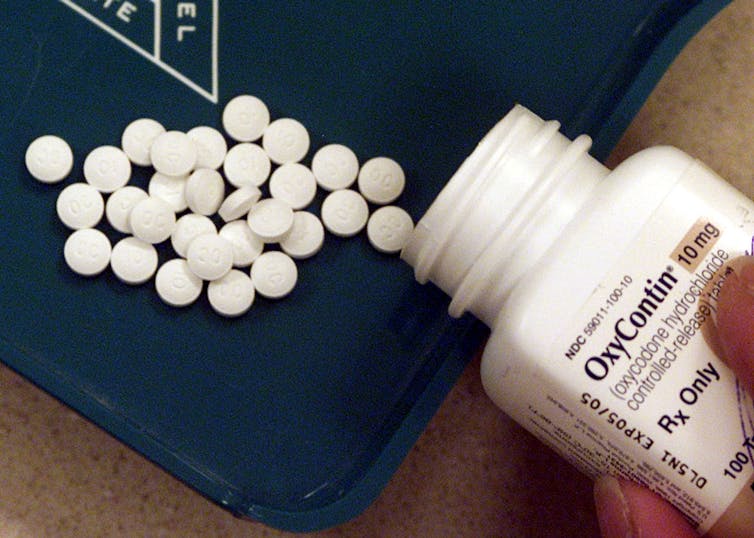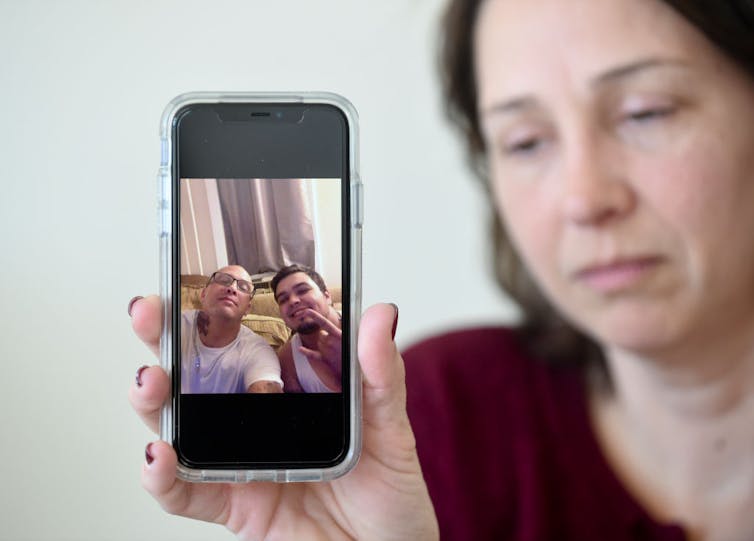OxyContin created the opioid crisis, but stigma and prohibition have fueled it
- Written by Emily B. Campbell, Visiting Assistant Professor of Sociology, College of the Holy Cross
The highly contentious[1] Purdue Pharma settlement[2] announced Sept. 1, 2021, comes at a pivotal time for the U.S. overdose crisis: 2020 was the worst year on record, with over 93,000 Americans[3] losing their lives to fatal drug overdose. The drug overdose epidemic, now more than two decades long, has claimed the lives of more than 840,000[4] people since 1999. Current estimates suggest that some 2.3 million people[5] in the U.S. use heroin and 1.7 million people[6] use pharmaceutical opioids without a prescription.
Since 2016, I’ve studied the overdose crisis[7] with an eye to understanding its roots as well as its ramifications. As a sociologist[8], I came to this area of research in my own quest for meaning, as each year brought more funerals of former classmates and friends. What I found was an increasingly dangerous drug environment for people who use drugs, often exacerbated by policies not founded in research and by attitudes that harm those affected.
How prohibition fuels dangerous markets
Research shows that the illicit drug market adapts[9] to both demand and drug enforcement efforts.
The first consequence of increased demand is that drugs become cheaper over time[10]. For example, the price of heroin and cocaine have been falling for decades. Political economists explain that demand, coupled with globalization, increases efficiency and competition. The result is that there are more drugs on the illicit market, which in turn lowers prices.
Second, as a response to drug prohibition, drugs become more potent[11]. A stronger product in a smaller package is easier to transport and harder to detect. The American overdose crisis has become a case study[12] in the devastating interplay of demand and prohibition.
OxyContin was released in 1996 and mass-marketed as a revolutionary intervention[13] in the medical treatment of pain. Purdue Pharma, its maker, knowingly downplayed[14] its addictive potential. As an opioid and central nervous depressant, OxyContin has effects[15] similar to those of morphine or heroin. Not surprisingly, studies show that prescription patterns of opioids from 1999 to 2008 were directly linked to a surge in overdose deaths[16].
 Oxycontin prescription-only pills were aggressively promoted to primary care physicians as a safe and effective pain control method for patients.
Lawrence K. Ho/Los Angeles Times via Getty Images[17]
Oxycontin prescription-only pills were aggressively promoted to primary care physicians as a safe and effective pain control method for patients.
Lawrence K. Ho/Los Angeles Times via Getty Images[17]
As concern over opioid overdose grew, doctors’ prescribing practices came under scrutiny[18]. In 2010, Purdue Pharma replaced the original OxyContin with an “abuse deterrent” formulation[19] that was more difficult to crush and inhale. As a result, many people who were addicted to OxyContin turned to heroin, which was cheaper and easier to get[20]. This spurred a surge in heroin-related fatal overdoses, which is often termed the second wave of the overdose crisis[21].
The growing market for heroin paved the way for the introduction of fentanyl[22] into the illicit U.S. drug market. Fentanyl, a drug used in medical settings for severe pain, is 50 times more potent than heroin[23]. From the standpoint of efficiency for shipping and trafficking, fentanyl is easier to transport and sell than heroin. Fentanyl’s entry into the illicit drug market, in particular in combination with heroin, led to a doubling and tripling [24]of overdose deaths around 2012 to 2013.
Since then, fentanyl[25] has contaminated[26] the U.S. illicit drug supply: It is often found in not just heroin but cocaine, MDMA – commonly known as Ecstasy – methamphetamine and counterfeit prescription pills. The result is that most people do not know the potency or contents[27] of what they are using.
As the overdose crisis evolves, communities of color[28] in particular have experienced a surge in fatal overdoses – deaths that are often preventable. And most recently, COVID-19 supply chain disruptions led people to use whatever was available, causing a surge in overdoses[29] from drug mixing.
Barriers to treatment
Too often, people who use drugs are bombarded with messages that are not supported by research and that deepen the harm.
Public health officials and community leaders urge people to seek treatment and highlight that recovery is within reach. Yet, roughly 70% of people who seek treatment are unable to access it[30]. Barriers to treatment[31] include health care costs, lack of available treatment options and social stigma. Research also demonstrates that some people are not ready for treatment or do not want to be sober[32].
Sobriety is touted as the ultimate goal for people who use drugs. Yet research shows that addiction is a recurring brain disease[33], and relapse is highly likely. Most people who use drugs do so in a sporadic way[34] that features bouts of controlled and uncontrolled use as well as sobriety. It is also well documented that fear of arrest and shame encourages people to hide their drug use in ways that increase their risk[35] of a fatal overdose. This is because when people use alone, there is no one there to call 911 or perform CPR should an overdose occur.
 Laurie Restivo’s brother, David Restivo, 47 (left on phone image), died from fentanyl-laced heroin, and her son, Jason Fisher Jr., 25 (right), died from fentanyl-laced cocaine.
Reading Eagle/MediaNews Group via Getty Images[36]
Laurie Restivo’s brother, David Restivo, 47 (left on phone image), died from fentanyl-laced heroin, and her son, Jason Fisher Jr., 25 (right), died from fentanyl-laced cocaine.
Reading Eagle/MediaNews Group via Getty Images[36]
In terms of effective treatment, medically assisted treatments[37] are considered the gold standard for opioid use disorder, yet they are still underutilized[38]. Buprenorphine[39] is an opioid with a “ceiling effect,” meaning it does not intoxicate like morphine or heroin but instead satiates an opioid craving. Buprenorphine assists people in transitioning away from uncontrolled use and mitigates physical cravings. People who are prescribed it are often able to work, attend therapy and regain enjoyment of day-to-day life.
Nonetheless, buprenorphine’s availability varies widely by state[40], and people of color are persistently underprescribed[41] this lifesaving medication. Methadone has been used as a treatment for opioid use disorder since the 1950s, yet it is persistently hard to access[42] long term. Researchers point to the ongoing role of stigma[43] in the underuse of both of these medications.
Better paths forward
Public health officials, harm reduction activists and concerned citizens across the U.S. are working to secure safer injection sites[44] where people can use drugs in the presence of medical staff. Such sites facilitate the prevention of fatal overdose by assuring an adequate and timely medical response and open a pathway for further health care and addiction-related treatment. In response to the pandemic’s strains on inpatient care facilities, take-home methadone[45] availability was expanded in new ways – a change that some treatment experts hope will be permanent[46].
For people who use drugs, the potency and contents of their drugs are often unknown[47]. Drug-checking programs[48] allow people to inspect the contents of their drugs for fentanyl[49] at home with a simple test strip. Such programs have recently gained traction with federal support[50]. States also continue to expand access to naloxone[51], an overdose reversal nasal spray that is simple to administer. People who use drugs or have loved ones who use drugs are encouraged to receive training on how to administer naloxone and to carry the nasal spray on them.
Those who argue for a safer supply[52] and decriminalization of drugs[53] point to success abroad. Heroin-assisted treatment[54] is shown to be effective in keeping people away from an unpredictable drug market, thus lowering the risk of overdose. Germany’s use of heroin-assisted treatment[55] improved patients’ physical and mental health while dramatically reducing illicit drug use. In the early 2000s, Portugal decriminalized[56] all drugs in response to consistently having the highest fatal overdose rates in Western Europe. With diversion of funds away from prohibition to education and treatment, Portugal saw a drop in overall drug use and now boasts among the lowest fatal overdose rates in Western Europe.
Americans are the world’s largest consumers[57] of drugs and consistently have among the highest rates of opioid and cocaine dependence globally. In my own research[58], I’ve found that people often describe drug use as a battle between sobriety and death. But the heartbreaking surge in accidental, fatal overdose deaths tells a much more complex story. Ignoring the evidence will surely cost many more lives.
If you or someone you care about has a substance use disorder and wants help, you can call SAMHSA’s National Helpline: 1-800-662-HELP (4357). Immediate emotional support is available from the National Suicide Prevention Hotline 800-273-8255.
[Get our best science, health and technology stories. Sign up for The Conversation’s science newsletter[59].]
References
- ^ highly contentious (theconversation.com)
- ^ Purdue Pharma settlement (www.npr.org)
- ^ 93,000 Americans (www.cdc.gov)
- ^ more than 840,000 (www.cdc.gov)
- ^ 2.3 million people (www.rand.org)
- ^ 1.7 million people (www.drugabuse.gov)
- ^ studied the overdose crisis (gc-cuny.academia.edu)
- ^ sociologist (www.holycross.edu)
- ^ the illicit drug market adapts (doi.org)
- ^ cheaper over time (doi.org)
- ^ drugs become more potent (doi.org)
- ^ a case study (doi.org)
- ^ mass-marketed as a revolutionary intervention (doi.org)
- ^ knowingly downplayed (www.nytimes.com)
- ^ OxyContin has effects (doi.org)
- ^ directly linked to a surge in overdose deaths (pubmed.ncbi.nlm.nih.gov)
- ^ Lawrence K. Ho/Los Angeles Times via Getty Images (www.gettyimages.com)
- ^ came under scrutiny (doi.org)
- ^ “abuse deterrent” formulation (doi.org)
- ^ cheaper and easier to get (doi.org)
- ^ second wave of the overdose crisis (doi.org)
- ^ introduction of fentanyl (doi.org)
- ^ 50 times more potent than heroin (www.drugabuse.gov)
- ^ led to a doubling and tripling (doi.org)
- ^ Since then, fentanyl (journals.lww.com)
- ^ has contaminated (doi.org)
- ^ do not know the potency or contents (doi.org)
- ^ communities of color (doi.org)
- ^ a surge in overdoses (ajph.aphapublications.org)
- ^ unable to access it (www.rcorp-ta.org)
- ^ Barriers to treatment (doi.org)
- ^ do not want to be sober (doi.org)
- ^ recurring brain disease (doi.org)
- ^ sporadic way (www.ucpress.edu)
- ^ increase their risk (doi.org)
- ^ Reading Eagle/MediaNews Group via Getty Images (www.gettyimages.com)
- ^ medically assisted treatments (doi.org)
- ^ underutilized (doi.org)
- ^ Buprenorphine (doi.org)
- ^ varies widely by state (doi.org)
- ^ persistently underprescribed (doi.org)
- ^ hard to access (doi.org)
- ^ ongoing role of stigma (doi.org)
- ^ safer injection sites (doi.org)
- ^ take-home methadone (doi.org)
- ^ hope will be permanent (doi.org)
- ^ potency and contents of their drugs are often unknown (doi.org)
- ^ Drug-checking programs (doi.org)
- ^ contents of their drugs for fentanyl (doi.org)
- ^ federal support (www.cdc.gov)
- ^ access to naloxone (www.ncbi.nlm.nih.gov)
- ^ safer supply (doi.org)
- ^ decriminalization of drugs (doi.org)
- ^ Heroin-assisted treatment (www.rand.org)
- ^ heroin-assisted treatment (doi.org)
- ^ Portugal decriminalized (doi.org)
- ^ largest consumers (doi.org)
- ^ my own research (gc-cuny.academia.edu)
- ^ Sign up for The Conversation’s science newsletter (theconversation.com)

















